April 17th, 2011 by Robert Cooper
 Not replying to emails is discourteous but I have to confess that I do it all the time! I simply receive far too many enquiries not only at my home email address but also at the office. I signed up for FaceBook and now have 147 friends with 113 wanting to become my friend and that generates even more contact and requests for information. I cannot access social networking sites such as FaceBook from the office which means I cannot use lunch breaks to answer posts and queries there and that means there is even less time to respond. Even this web site with its ‘contact’ page creates email. So what is to be done? Not a lot I think as the cat is now not only out of the bag but is half way to Loch Lomond!
Not replying to emails is discourteous but I have to confess that I do it all the time! I simply receive far too many enquiries not only at my home email address but also at the office. I signed up for FaceBook and now have 147 friends with 113 wanting to become my friend and that generates even more contact and requests for information. I cannot access social networking sites such as FaceBook from the office which means I cannot use lunch breaks to answer posts and queries there and that means there is even less time to respond. Even this web site with its ‘contact’ page creates email. So what is to be done? Not a lot I think as the cat is now not only out of the bag but is half way to Loch Lomond!
The purpose of this blog is therefore to let everyone know that I know the problem and am sorry for not replying to 100s of emails that are still sitting unread in my Inbox (see image for proof that I am not kidding!)
So please remember that although I might have received your email it might have got lost amongst the large number that arrive everyday. Oh, and calling often does not work either because I am trying to read an answer my emails…
Posted in Uncategorized having no comments »
April 16th, 2011 by Robert Cooper
The Euro zone is that part of the European Union (established in 1993) that has a common currency the Euro (€). Presently their are 17 countries who are members of the Euro zone and 10 which are not (see below for a list of the countries).
Scotland is presently part of the United Kingdom which has the monetary unit known and the pound (£) or sterling (or pound sterling). The currency (paper money and coins) are issued under the authority of the Bank of England (not called the Bank of the United Kingdom or even the Bank of Britain). However, a quirk of history allows Scottish banks to issue their own paper money (but not coins). Scottish banknotes circulate widely in the United Kingdom (although in some places they are rare and some people are therefore a bit suspicious of them) but because they are not issued by the Bank of England (which is the Bank of the United Kingdom despite the (inaccurate) title) they are therefor not legal tender in a precise legal definition.
When a country joins the Euro zone it gives up the right to have it’s own currency but issues Euro notes and coins with the country’s name on them together with other things appropriate to that country. My desire for the UK not to join the Euro zone has nothing to do with monetary policy, economics or politics. It stems directly from my interest in the history and culture of Scotland. Scotland is part of the UK so on joining the Euro it would be bound by the rules for issuing the Euro currency which does not allow for constituent parts of a country to has their own Euro notes. For example Bavaria, part of Germany, cannot and does not have its own Euro coins and notes. So, although I doubt many would deny that Scotland is a nation, Scottish banks would not be allowed to retain the right to issue their own banknotes.
Apart from Scottish banknotes disappearing on joining the Euro, Scots would also loose a daily visual reminder of its past, its history and its famous people.
- Belgium
- Germany
- Estonia
- Ireland
- Greece
- Spain
- France
- Italy
- Cyprus
- Luxembourg
- Malta
- The Netherlands
- Austria
- Portugal
- Slovenia
- Slovakia
- Finland
Non-participants in the Euro zone are: Bulgaria, Czech Republic, Denmark, Latvia, Lithuania, Hungary, Poland, Romania, Sweden and the United Kingdom. Although they are EU Member States they do not presently use the single European currency.
Posted in Uncategorized having no comments »
April 10th, 2011 by Robert Cooper
 Does your local supermarket have a ‘greeter’, that is someone who meets you as you enter? My local supermarket, ASDA, did. The first time I went there soon after it as opened I was met by one of their ‘greeters’ complete with an official badge – ASDA GREETER. I fell about laughing. Very quickly the women ‘greeter’ could not keep a straight face and was also in stiches. When we both stopped laughing she said ‘I was made to do it, I had no choice’. That was about nine years ago. She knew what she was being asked to do but had apparently been over-ruled by ignorant international management (ASDA UK is owned by Walmart USA).
Does your local supermarket have a ‘greeter’, that is someone who meets you as you enter? My local supermarket, ASDA, did. The first time I went there soon after it as opened I was met by one of their ‘greeters’ complete with an official badge – ASDA GREETER. I fell about laughing. Very quickly the women ‘greeter’ could not keep a straight face and was also in stiches. When we both stopped laughing she said ‘I was made to do it, I had no choice’. That was about nine years ago. She knew what she was being asked to do but had apparently been over-ruled by ignorant international management (ASDA UK is owned by Walmart USA).
So why the laughter? Well… the reason lies in the fact that Scots is a separate language from English. As an aside I shall be touching on that my lecture at the International Conference on the History of Freemasonry (ICHF) at the end of May. In Scots someone who ‘greets’ (grete, grat, gretis are Scots variant spellings) is someone who crys tears of sorrow. So, instead of the intention to ‘greet’ customers in a welcoming manner they were being being meet with someone who was tearful and full of woe!
As another aside in relation to Freemasonry. When the Reigning Master of a Scottish Lodge presides over his last meeting it is known as his ‘Greetin Meeting’ and is therefore his farewell meeting to which most of his Masonic friends try to attend.
ASDA UK is owned by Walmart an American company and so I suppose that they have some small excuse for not knowing the history and culture of another country. The employees who now meet you on entering their supermarkets no longer wear a badge proclaiming them to be a ‘greeter’.
Posted in Uncategorized having no comments »
April 7th, 2011 by Robert Cooper
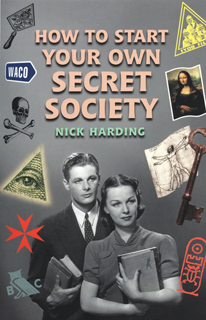 So you are not a Freemason? There could be a whole host of reasons why you are not a Freemason but the Freemasons of Scotland have a saying: ‘There are millions of Freemasons ‘out there’ they just don’t know it yet’. I expect that Masonophobes will have many other opinions as to why you should not be a Freemason. Those aside one of the most common that I hear frequently is: ‘I have never been asked!’ The reason why you will not be asked is due to the curious history of Freemasonry itself. Freemasonry, as an organisation (and I really dislike that label when applied to Freemasonry but that is for another post), does not recruit! How weird is that! Freemasonry, in the UK and Europe at least, does not go out to ‘sign up’ new members. You will not find people in city centres handing out publicity material. There is a very particular reason for this which is embedded in the history and ritual of Freemasonry, particularly Scottish Freemasonry, but until one becomes a member that reason cannot be revealed.
So you are not a Freemason? There could be a whole host of reasons why you are not a Freemason but the Freemasons of Scotland have a saying: ‘There are millions of Freemasons ‘out there’ they just don’t know it yet’. I expect that Masonophobes will have many other opinions as to why you should not be a Freemason. Those aside one of the most common that I hear frequently is: ‘I have never been asked!’ The reason why you will not be asked is due to the curious history of Freemasonry itself. Freemasonry, as an organisation (and I really dislike that label when applied to Freemasonry but that is for another post), does not recruit! How weird is that! Freemasonry, in the UK and Europe at least, does not go out to ‘sign up’ new members. You will not find people in city centres handing out publicity material. There is a very particular reason for this which is embedded in the history and ritual of Freemasonry, particularly Scottish Freemasonry, but until one becomes a member that reason cannot be revealed.
You could try to join a real secret society such as the Mafia, Triads or Yakuza but I don’t recommend that because, well, those are real secret societies who probably do not want loads of people knocking on their door asking to join. Alternatively you could try to become a ‘real’ Freemason but, of course, how to do that is a secret!
All is not lost however! You could always start up your own secret, ‘secret society’, and should you wish to do so help is at hand! Five years ago to assist people aspiring to become members of a ‘secret society’ but who had some reason not to become a Freemason one Nick Harding wrote a book: How to start your own Secret Society published by Oldcastle Books. DIY Freemasonry!
Posted in Uncategorized having no comments »
April 4th, 2011 by Robert Cooper
Holy Blood, Holy Grail, Holy S***! I have just finished Voodoo Histories by David Aaronovitch and this is the title of one of the chapters. Guess what it is about? Of course it is about the book The Holy Blood and the Holy Grail. By Michael Baigent, Richard Leigh and Henry Lincoln published in 1982 (and many times thereafter). As you might imagine 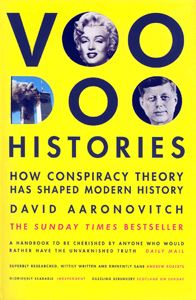 given the discussion in my earlier post about Aaronovitch’s book this chapter is not complimentary about The Holy Blood and the Holy Grail and the sequels The Messianic Legacy and The Temple and the Lodge.
given the discussion in my earlier post about Aaronovitch’s book this chapter is not complimentary about The Holy Blood and the Holy Grail and the sequels The Messianic Legacy and The Temple and the Lodge.
What caught my attention was Aaronovitch’s discussion of this kind of writing in a book about conspiracy theory. His reasons for including this form of writing about the past, known as pseudo-history, and particularly books by these authors is because he sees a pattern common in all conspiracies – that the authorities are dliberately misleading us, the unsuspecting public. In this case the authority in question is the church, that is the Roman Catholic church. For the very few of you who do not already know – what the church does not want us to know (according to these authors) is the fact that Jesus Christ and Mary Magdalene were lovers and had children. After Christ was crucified Mary fled to Gaul (France) with their children. The blood of Christ was then carried from the children of Christ and Mary down to modern times through the Merovingian dynasty, the House of Lorraine and the Knights Templar (to name but a few). Behind them all, watching, waiting, protecting the Holy Blood line is the Priory of Sion. You get the drift.
For me as an historian what is of most interest is Aaronovitch’s examination of the methodology used by the authors. He focuses on an introductory paragraph:
‘It was necessary for us to synthesise in a coherent pattern data extending to from the.. Gospels and Grail romances to accounts of current affairs in modern newspapers… For such an undertaking the techniques of academic scholarship were sorely inadequate. To make the requiste connections between radically diverse bodies of subject matter we were obliged to adopt a more comprehensive approach, based on synthesis rather than conventional analysis.’
In other words the analytical and ‘coventional’ practices of the modern historian are inadequate to the task of linking together such things a: the Bible, Jesus Christ, Holy Grail, Knights Templar, modern newspaper articles and ‘modern thinking’ together to create a cohesive story.
Where Aaronovitch leaves oof I continue. I fail to understand the methodology of such authors not because they fail to say what it is but because they fail to explain the process. They are up front in declaring that they have rejected conventional methods and substituted a comprehensive approach, based on ‘synthesis’ but what does that mean? How is it applied? A ‘comprehensive approach’ suggests that anything and everything can be used but even that possibility is not clear. By not explaining what this methodology actually is, rather than simply providing weighty sounding descriptions, it is impossible to decide if the authors have a methodology at all or are simply making one up. Voodoo Histories argues that the latter is true.
Perhaps those who wish to cling to the mythology created by writers such as these ought not to read Aaronovitch’s book!
Posted in Uncategorized having no comments »
March 29th, 2011 by Robert Cooper
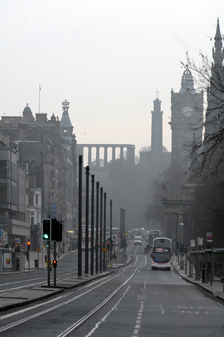 My home town of Edinburgh was to have had a tram system in operation on 25 February 2011. The decision was taken in 2006 when, despite the Scottish government’s opposition to the scheme, the other political parties (Scottish Labour, Scottish Conservatives, Scottish Greens, and the Scottish Liberal Democrats) joined forces to allow the City of Edinburgh Council (CEC) proceed with the scheme. The Scottish National Party (SNP) whose administration had been against the plan decided that the financial committment of the taxpayer should be limited to that initially proposed – £500 million. The CEC was to contribute approximately £45 million with additional funds being ingathered from buisnesses along the tram route.
My home town of Edinburgh was to have had a tram system in operation on 25 February 2011. The decision was taken in 2006 when, despite the Scottish government’s opposition to the scheme, the other political parties (Scottish Labour, Scottish Conservatives, Scottish Greens, and the Scottish Liberal Democrats) joined forces to allow the City of Edinburgh Council (CEC) proceed with the scheme. The Scottish National Party (SNP) whose administration had been against the plan decided that the financial committment of the taxpayer should be limited to that initially proposed – £500 million. The CEC was to contribute approximately £45 million with additional funds being ingathered from buisnesses along the tram route.
There is not enough space here to provide all the facts and it is a pity that there is not a web site that is dedicated solely to this subject. Some idea of the debate can be seen by reviewing the news items and comments on the Edinburgh Evening News web site. To go there click here or on the previous link.
The bottom line is that here we are five years later and the work is at a standstill and has been for two years. There have been some tram rails laid in Princes Street (see photograph) but as far as I can tell these are all that have been installed. Apparently nearly all the funds allocated for the project have been spent and with no more money available from the Scottish government the debate is whether the citizens of Edinburgh will get a single tram line let alone a tram system.
The photograph shown here is of Princes Street looking east. Down the centre of the street stands a row of pillars erected to carry the power cables to be used by the tram cars. In the distance is Carlton Hill and at the right one can see ‘Edinburgh’s Disgrace‘ – the row of columns. To the right of that is the Nelson Monument who died at the battle of Trafalgar (1805). At the far end of the street also on the right (but ‘in front’ of Carlton Hill) is the clock tower of The Barmoral hotel. The clock is always a few minutes fast so that train passengers going to Waverly Station immediately adjacent to the hotel have a little time in hand. In the middle foreground and again on the right is the Scott Monument built to commemorate one of Sotland’s literary giants, Sir Walter Scott (1771 – 1832). The photograph was taken on a slightly mistly morning just after dawn adding an atmospheric touch to the scene.
Posted in Uncategorized having no comments »
March 25th, 2011 by Robert Cooper
Taking photographs has been part of my life for a very long time. I must say that I am not claiming to be a great photographer but there are a few of my attempts to capture places I have been fortunate enough to visit in a gallery on this web site. To have a look click here or on the previous link.
 This piece is not so much about the art of photography as the tools used to create them – cameras and lenses. Although I used to use Canon camera equipment when the company changed from their FD mount to another version (the EF mount) in 1987 all my equipment became obsolete. Oh, I could have carried on using the equipement but over time I would have had fewer and fewer options. So… I took the plunge and swtiched to Nikon and have never regretted it until recently. Nearly all Nikon lenses will fit the latest digital camera bodies albeit with varying degrees of functionality. That means that I can still use quality manual focus lenses that I purchased 20 years ago.
This piece is not so much about the art of photography as the tools used to create them – cameras and lenses. Although I used to use Canon camera equipment when the company changed from their FD mount to another version (the EF mount) in 1987 all my equipment became obsolete. Oh, I could have carried on using the equipement but over time I would have had fewer and fewer options. So… I took the plunge and swtiched to Nikon and have never regretted it until recently. Nearly all Nikon lenses will fit the latest digital camera bodies albeit with varying degrees of functionality. That means that I can still use quality manual focus lenses that I purchased 20 years ago.
My ‘best’ camera was a D2X which I purchased new in 2006 for £4000. It is a professional camera – that is one designed and build to be used day in day out in every conceivable situaltion. It was a superb camera but like all cameras it has its limitations (high ISO speeds resulted in very grainy images for example). However, I as do not need huge enlargements and usually have pleanty of light this was never a problem for me as a semi-pro. Until, that is, one night in 2010 whilst on assignment the camera just froze. The last image was stayed displayed on the screen but nothing would work. Switching it off and on again just make the image disappear and changing the battery for a fully charged one had no effect. I had to resort to an older D1X (which still delivered acceptable images) but it was not a good experience in the middle of a photo shoot.
The camera body was taken to the camera repair shop, Cameratiks in Edinburgh, whom my wife and I have used for years. They could not diagnose the problem it and so it was sent to Nikon for an estimate for repair. That came back at £350. Hmm… but as I like the camera so much and eBay were selling second hand D2X’s in the region of £500 – £600 I went for it and asked Cameratiks to inform Nikon that I accepted their estimate and to proceed with the repair. Then woe, Nikon explained that whilst carrying out the repair had discovered more problems and the estimate was now £950! That was just too expensive. Having had a professional camera for four years during which time it only had light use that meant that it had cost £1000 per year to use. Was it worth another £1000 to repair? I decided not and bought a second hand one from eBay. But I am still wary of sudden failure. Should I get the new second hand one serviced? How much would that cost and would it be worth it? When the estimate for £950 came back from Nikon and was rejected I was then asked – ‘Do you want the camera back?’ Given the high annual cost of using the camera (£1000 per annum) and high repair costs I wonder if there is something fundamentally wrong with this particular model and Nikon wants them out of circulation? It is probably my suspicious mind but I can’t shake that nagging feeling…
Just to make things worse I had decided that as I was happy with the DX format (the FX is superb but I cannot justify the cost) I invested in a variety of DX lenses and so I am stuck with DX bodies of which the D2X is my favourite. Ho hmm…
Posted in Uncategorized having no comments »
March 18th, 2011 by Robert Cooper
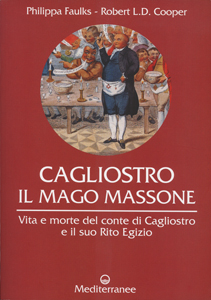 Although still slowly reading through The Red Triangle (and taking notes as I go along) I have found time to do other things (as well as working!) One of main projects is preparing a paper for the International Conference on the History of Freemasonry (ICHF) which takes place in Alexandria, Viriginia, USA, at the George Washington Masonic Memorial. Attending the conference pushed me to finally get round to continuing something I should have tackled sometime ago. The paper is entitled ‘The Earliest Masonic Rituals – Context and Content’. By taking on the research for a paper after the title has been announced can create problems – what if the material being researched does not deliver what is anticipated? Time will tell but it has been interesting becoming re-acquainted with the Scottish National Archive which, I believe, still has to reveal more very early Masonic ‘gems’.
Although still slowly reading through The Red Triangle (and taking notes as I go along) I have found time to do other things (as well as working!) One of main projects is preparing a paper for the International Conference on the History of Freemasonry (ICHF) which takes place in Alexandria, Viriginia, USA, at the George Washington Masonic Memorial. Attending the conference pushed me to finally get round to continuing something I should have tackled sometime ago. The paper is entitled ‘The Earliest Masonic Rituals – Context and Content’. By taking on the research for a paper after the title has been announced can create problems – what if the material being researched does not deliver what is anticipated? Time will tell but it has been interesting becoming re-acquainted with the Scottish National Archive which, I believe, still has to reveal more very early Masonic ‘gems’.
As well as that, the book The Masonic Magician, co-authored with Pip Faulks, has now been published in Italian. This was a very pleasant surprise especially as so few British authors writing on Freemasonry seem to be successful in having their work published outside the UK. It is a complaint I have heard regularly on the ‘circuit’ and wonder if it is something to do with the small world of Bristish Masonic publishing? Of course the economic situation might also play a part. For details of the contents of the book please see the blogs below. For those who might be interested in the Italian edition it is published by Edizioni Mediterranee, Paperback. 282 pages, €22.50.
But it is not all work, the paper for ICHF excepted, and several books have come my way. I always seem to be juggling 4 – 5 at any one time. I am not a ‘speed reader’ as I suspect most book reviewers seem to be and so I lug current books around from place to place. I really do try to look after my books (I have been know to cover them in heavyweight brown paper to protect them if I am taking them on my travels) but paperback are wee bitty worn once I have finished with them.
juggling 4 – 5 at any one time. I am not a ‘speed reader’ as I suspect most book reviewers seem to be and so I lug current books around from place to place. I really do try to look after my books (I have been know to cover them in heavyweight brown paper to protect them if I am taking them on my travels) but paperback are wee bitty worn once I have finished with them.
The one (or the 4 or 5) that has caught my particular attention is: Voodoo Histories – How Conspiracy Theory Has Shaped Modern History by David Aaronovitch. The author was writing his book at exactly the smae time I was writing The Red Triangle but his was published before mine. I really regret not having it to hand whilst I was writing might it would have answered quite a few questions I admit that I could not answer and it would have saved me doing some research as that had alread been done by him. That said his focus is quite different from mine. As the sub-title suggests he is looking at conspiracy theories in general whereas The Red Triangle is very much more focused on Freemasonry. The two, in my mind at least, go well together but I do not know if David Aaronovitch would welcome that suggestion!
The first chapters are devoted to trying to understand the nature of conspiracies, what are their causes, whom they appeal to, how they evolve and what purposes they might serve. Groups who are claimed to be responsible are identified before moving onto examining actual conspiracies (real or imagined) the first of which is the conspiracy against the Soviet Union by members of the ruling elite who attempted to bring the new communist state crashing down. Fascinating stuff.
More to follow….
Posted in Uncategorized having no comments »
March 13th, 2011 by Robert Cooper
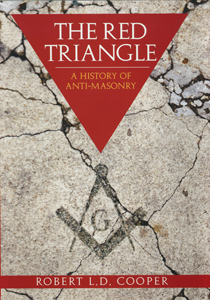 Surprisingly perhaps I am re-reading my recently published book: The Red Triangle. The reasons why will follow later. Since my last post of more than a year ago (yes, 12 months!) I have been working on bringing my latest book to fruition. This time it has been a long and difficult process. In fact occasionally the experience has been downright unpleasant. I will try to explain that in more detail later.
Surprisingly perhaps I am re-reading my recently published book: The Red Triangle. The reasons why will follow later. Since my last post of more than a year ago (yes, 12 months!) I have been working on bringing my latest book to fruition. This time it has been a long and difficult process. In fact occasionally the experience has been downright unpleasant. I will try to explain that in more detail later.
I submitted a roughly polished draft of the manuscript to the publisher on 7th April 2010 (which was, admittedly, very late) and it was published on Monday, 21st February 2011. Naturally, I was interested to see what had been produced. This is because an author does not get to see (at least at my humble level) what a publisher will do with his work. I am sure Dan Brown is not (at least now) treated in this manner. It seems that once a publisher has ‘got the goods’ they are totally focuses on get the book onto the bookshop shelves (although I have not seen any of mine in Waterstones or Barns and Noble) and the author is largely forgotten. This is simply a statement of fact and I am sure that many other authors have had the same experience.
The dust jacket was another contentious issue. The one shown at top left is the one the publishers decided 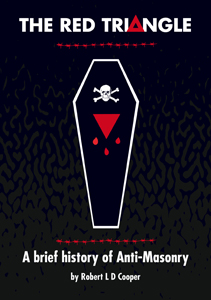 to go with and the one to the right is the one I very much preferred. It is always a problem when an author thinks one thing and a publisher another. The publisher makes a judgement which is based on appealing to a particular market I, as an author, makes a judgement on the basis of whom I believe I am writing for – in this case Freemasons first and the general public second. The cover I imagined and then had designed (at my own expense) is shown here to the right. I cannot explain or imagine why the dust jacket (above left) was used for the book. I can, however, explain in detail why I would have preferred the dust cover (right) to have been used.
to go with and the one to the right is the one I very much preferred. It is always a problem when an author thinks one thing and a publisher another. The publisher makes a judgement which is based on appealing to a particular market I, as an author, makes a judgement on the basis of whom I believe I am writing for – in this case Freemasons first and the general public second. The cover I imagined and then had designed (at my own expense) is shown here to the right. I cannot explain or imagine why the dust jacket (above left) was used for the book. I can, however, explain in detail why I would have preferred the dust cover (right) to have been used.
To do explain that it is necessary to appreciate that the book discusses a dark subject (for Freemasons at least) and that is known as anti-Masonry. Even that is inaccurate as the term ‘anti-Masonry’ is abandoned very early in the book and replaced by a new word – Masonophobia. This word emerged recently to explain the nasty and spiteful edge that attacks on Freemasonry have taken on over the recent past. So the book cover to the right is an attempt to covey all that. The red strands of barbed wire at top and bottom as suggestive of the concentration camps were so many Freemasons (and other ‘undesireables’) ended up. The coffin shape also suggests the camps but also reminds us of the lessons of the third degree. I often wonder if Masonic ritual brought any comfort to those waiting to die? In or on the coffin is a skull and crossed bones. Again this is symbolic of the deaths of Freemasons but also refers to an very emotional part of the Third Degree charge ‘Behold it is a skull… ‘ and what Freemasons are to try and do with their remaining days. By coincidence it is also is an emblem used by the German SS. The three drops of blood are reminiscent of tears of sorrow for the departed but also, again, indicate the three degrees of Freemasons which all Freemasons must have experienced to become a Master Mason. Finally, the red triangle is the symbol which Freemasons were forced to wear by the Nazi regime.
It is not possible to provide a detailed review of the content of the book here but if you are at all interested there is an interview of me talking about The Red Triangle on YouTube and to see that (it is eight minutes long so I don’t expect you to!) click here or on previous links.
Someone asked me what it was like being on YouTube? Frankly it was not like anything at all! It is nothing like being on the telly or radio. All that needs to be done is look at and speak to a video camera (why do we still call them that?) and then upload the result to YouTube. Fame for everyone!
More to follow…
Posted in Uncategorized having no comments »
January 4th, 2010 by Robert Cooper
Snow has been lying for more than three weeks in Edinburgh and it has been bitterly cold throughout that time. That means that for the first time in many years Edinburgh had a white Christmas and New Year. Normally this is not the time I would be reading much of anything but the incentive has been to stay indoors more than normal.
The visit of our friends Rick and Darleen from Phoenix, Arizona, meant that we did venture out a few times including, of course, a trip to Rosslyn Chapel. The roads and pavements were very difficult but despite this we were surpised to find approximately 50 visitors to the chapel in mid afternoon on Teusday, 29th December. The other main outing was to the pantomime. We went to the King’s Theatre to see Robinson Crusoe and the Caribbean Pirates. As always the panto was great fun and our friends thourghly enjoyed a type of ‘play’ that is virtually unknown in America. A great time was had by all and the five days spent in the company of friends and family reinforced the desire to pay more attention to others in the year ahead.
Of course, I have read The Lost Symbol (of which more in another posting) but as this is the holidays I have been reading a diverse range of material as much for pleasure as anything else.
Guess what? I have forgotten how to upload images! What a twit. I shall work it out sometime. Mean while in frozen Scotland, it was -15C here in Edinburgh last night (7th Jan.) – I have been working on my ‘lastest’ book. I say ‘latest’ because it is very late, about a year late so far. Entitled: The Red Triangle it is due to be published by Ian Allan Publications later this year under their Lewis Masonic imprint – once I have finished it! I must say that Ian Allan Publications have been very understanding about the long delay. It is really great to have an understanding publisher!
More to follow..
Posted in Uncategorized having no comments »
 Not replying to emails is discourteous but I have to confess that I do it all the time! I simply receive far too many enquiries not only at my home email address but also at the office. I signed up for FaceBook and now have 147 friends with 113 wanting to become my friend and that generates even more contact and requests for information. I cannot access social networking sites such as FaceBook from the office which means I cannot use lunch breaks to answer posts and queries there and that means there is even less time to respond. Even this web site with its ‘contact’ page creates email. So what is to be done? Not a lot I think as the cat is now not only out of the bag but is half way to Loch Lomond!
Not replying to emails is discourteous but I have to confess that I do it all the time! I simply receive far too many enquiries not only at my home email address but also at the office. I signed up for FaceBook and now have 147 friends with 113 wanting to become my friend and that generates even more contact and requests for information. I cannot access social networking sites such as FaceBook from the office which means I cannot use lunch breaks to answer posts and queries there and that means there is even less time to respond. Even this web site with its ‘contact’ page creates email. So what is to be done? Not a lot I think as the cat is now not only out of the bag but is half way to Loch Lomond!







